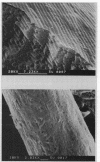Abstract
Engineering approaches used in the study of textile fibers have been applied to the measurement of mechanical properties of bacterial cell walls by using the Bacillus subtilis bacterial thread system. Improved methods have been developed for the production of thread and for measuring its mechanical properties. The best specimens of thread produced from cultures of strain FJ7 grown in TB medium at 20 degrees C varied in diameter by a factor of 1.09 over a 30-mm thread length. The stress-strain behavior of cell walls was determined over the range of relative humidities between 11 and 98%. Measurements of over 125 specimens indicated that cell wall behaved like other viscoelastic polymers, both natural and man-made, exhibiting relaxation under constant elongation and recovery upon load removal. This kinetic behavior and also the cell wall strength depended greatly on humidity. The recovery from extension observed after loading even up to a substantial fraction of the breaking load indicated that the properties measured were those of cell wall material rather than of behavior of the thread assemblage. Control experiments showed that neither drying of thread nor the length of time it remained dry before testing influenced the mechanical properties of the cell walls. Specimens drawn from TB medium and then washed in water and redrawn were found to be stiffer and stronger than controls not washed. However, tensile properties were not changed by exposure of cells to lysozyme before thread production. This suggests that glycan backbones are not arranged along the length of the cell cylinder. The strength of the cell wall in vivo was estimated by extrapolation to 100% relative humidity to be about 3 N/mm2. Walls of this strength would be able to bear a turgor pressure of 6 atm (ca. 607.8 kPa), but if the increase in strength of water-washed threads was appropriate, the figure could be 24 atm (ca. 2,431.2 kPa).
Full text
PDF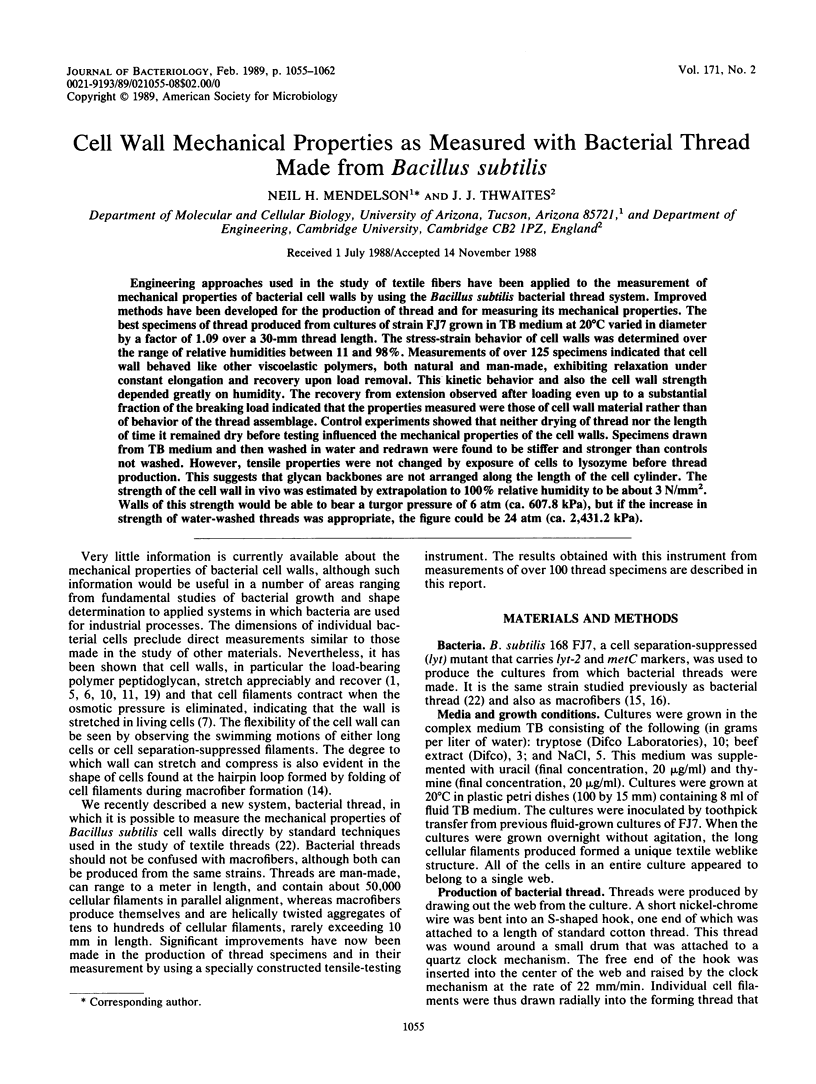
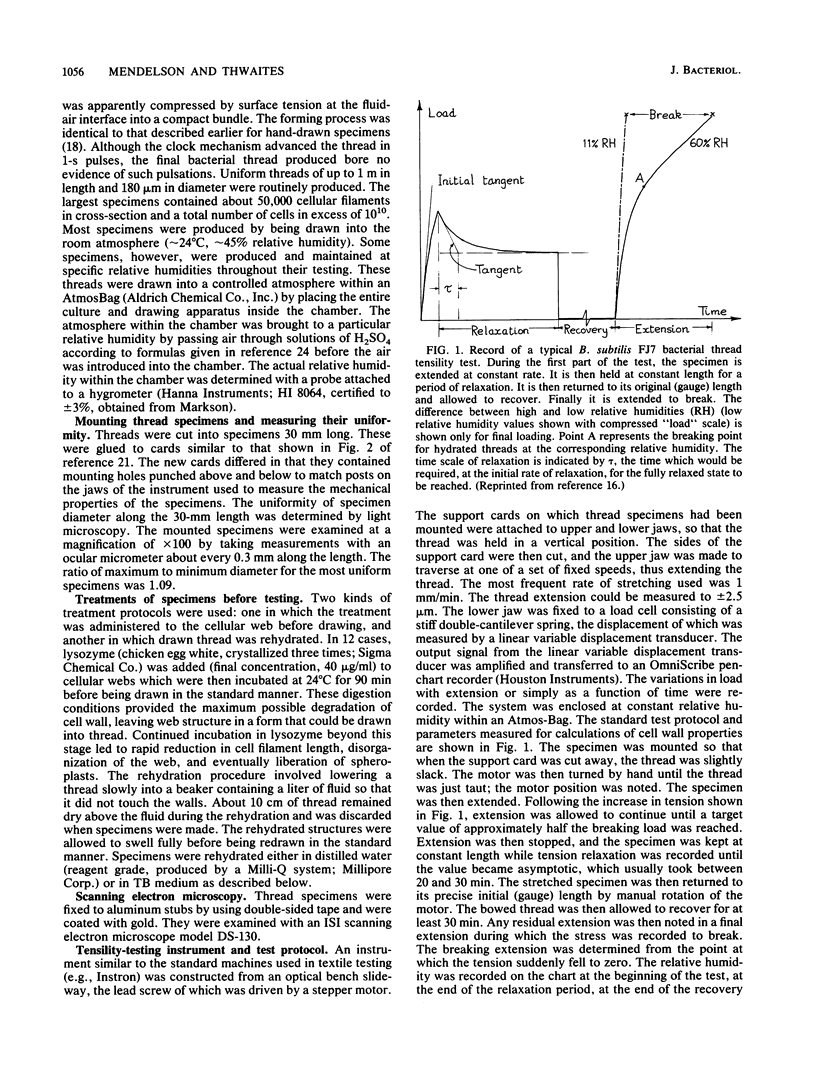
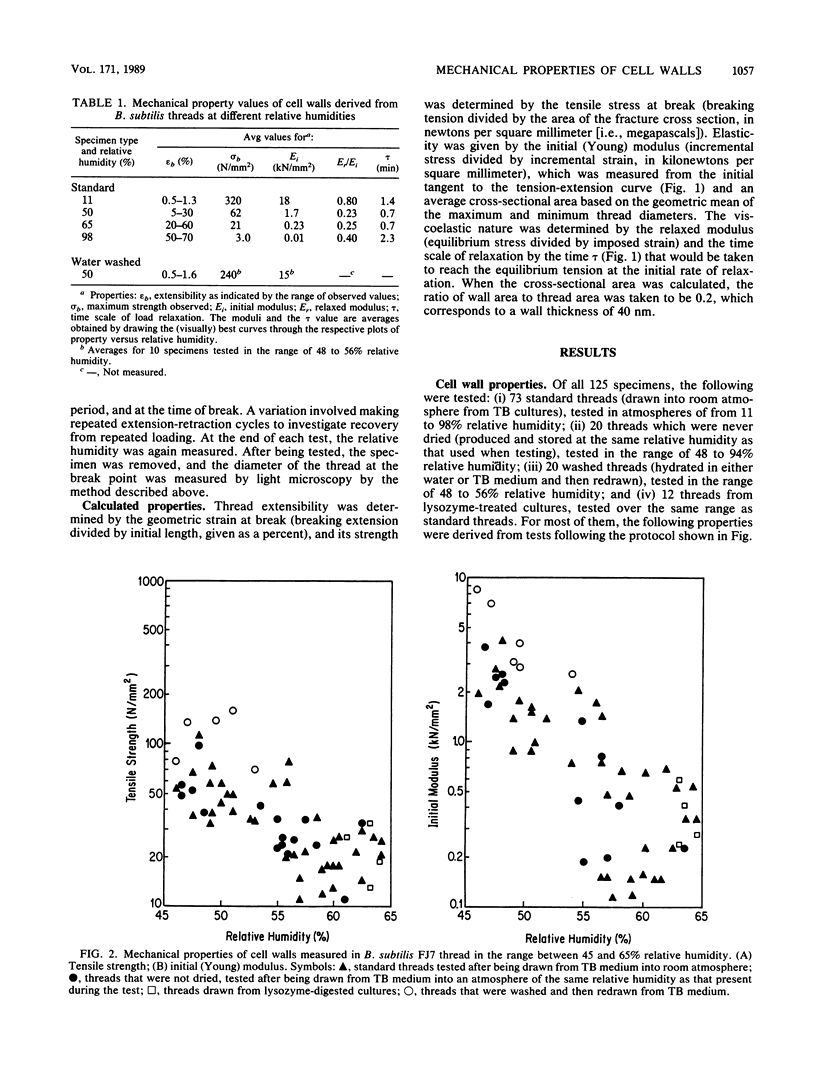
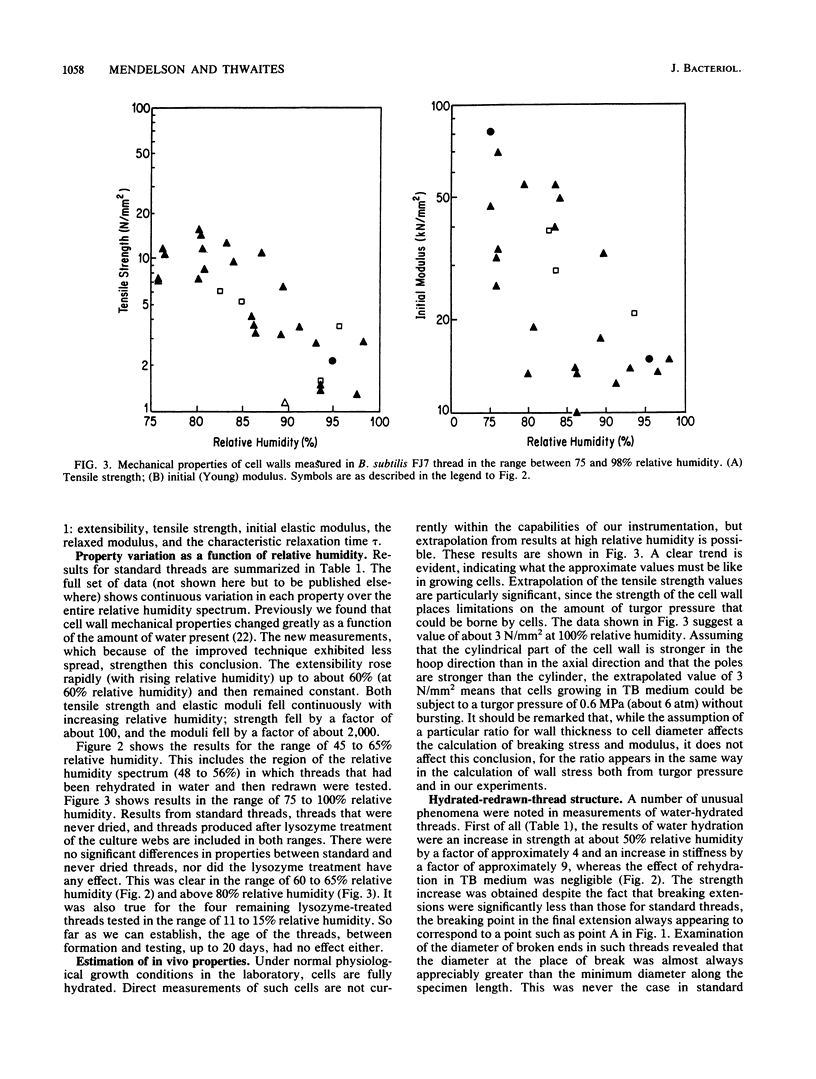
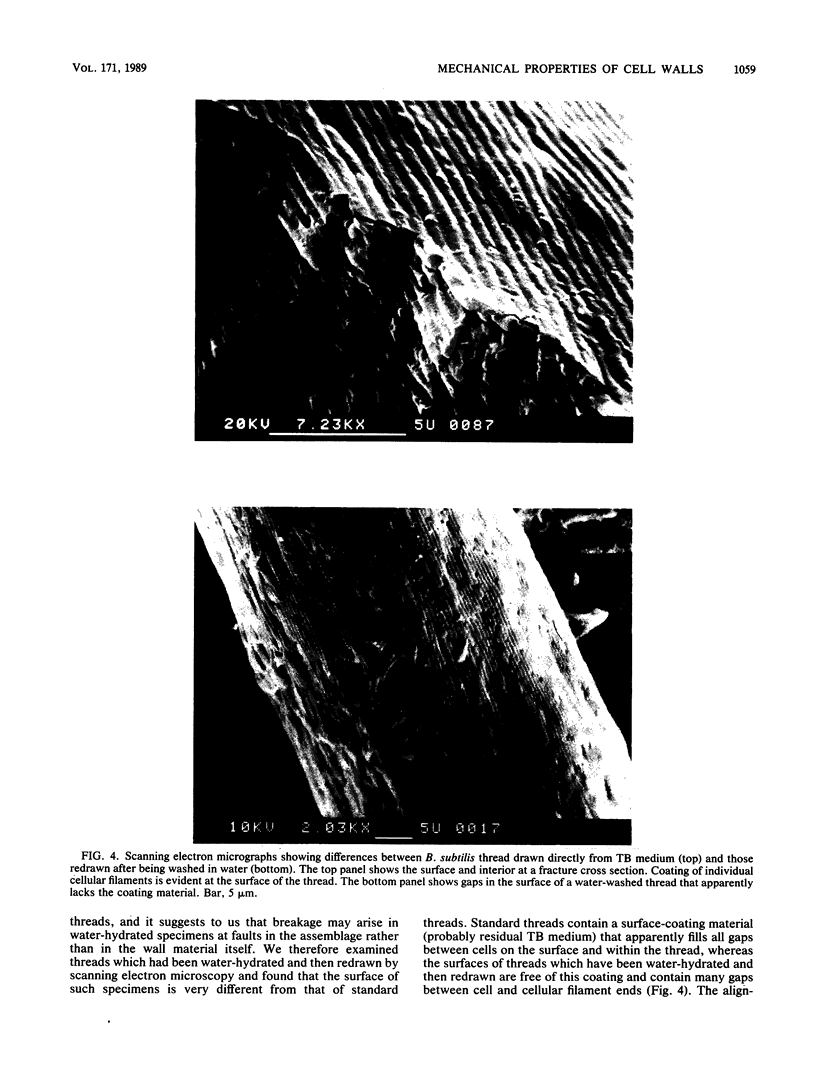
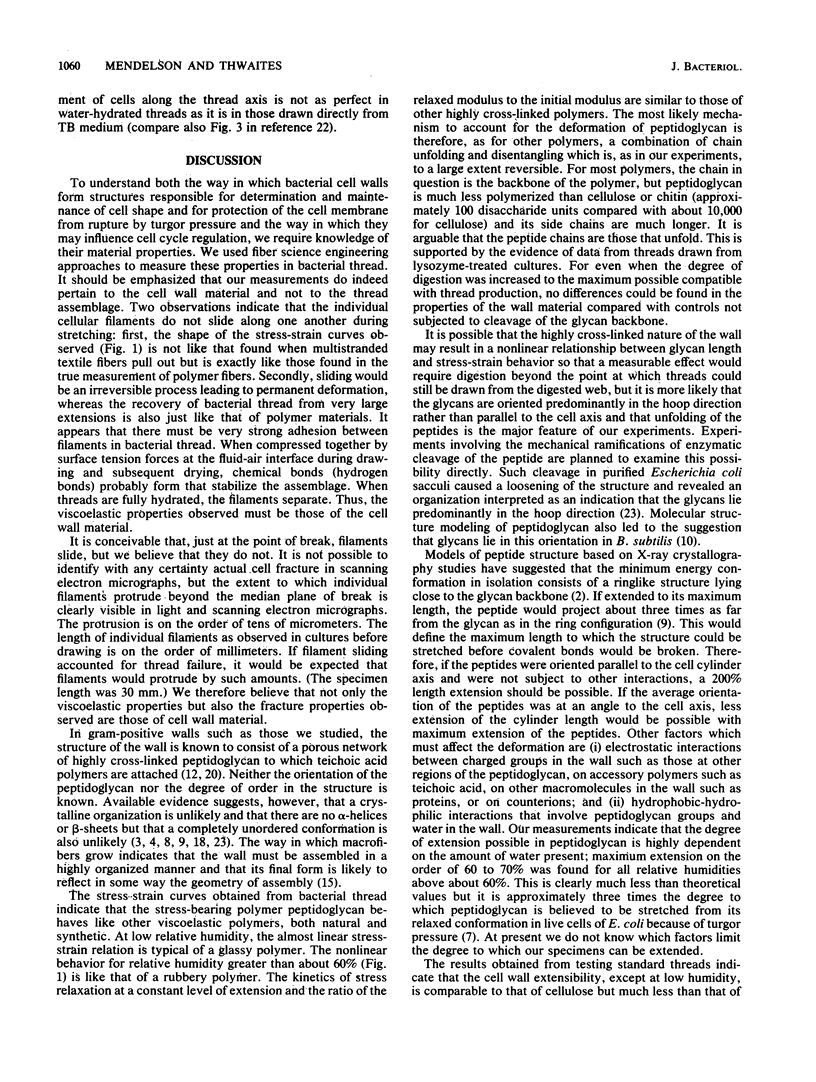
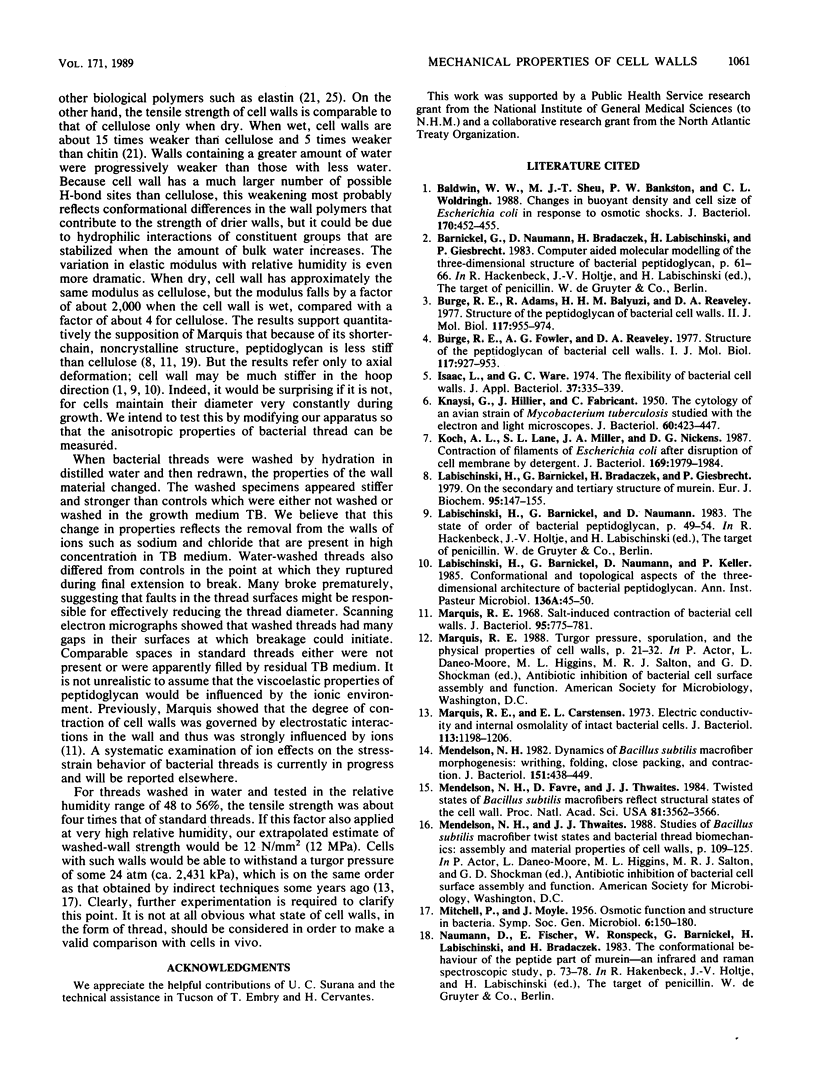
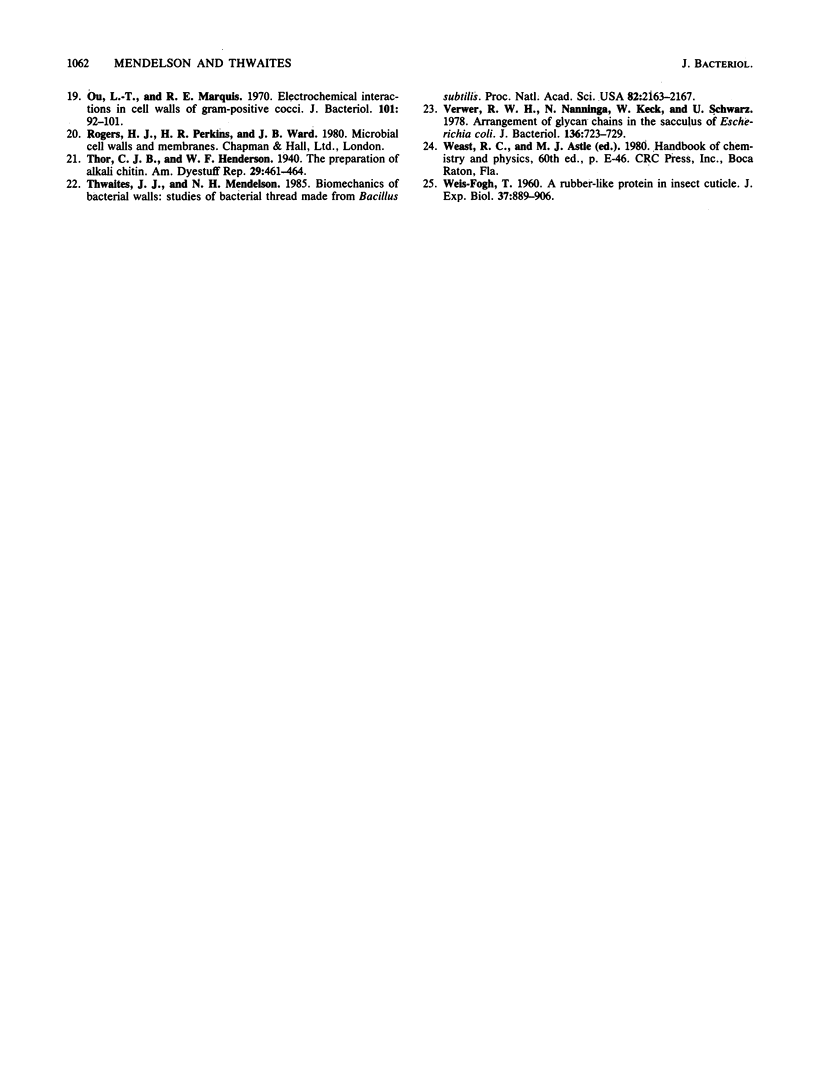
Images in this article
Selected References
These references are in PubMed. This may not be the complete list of references from this article.
- Baldwin W. W., Sheu M. J., Bankston P. W., Woldringh C. L. Changes in buoyant density and cell size of Escherichia coli in response to osmotic shocks. J Bacteriol. 1988 Jan;170(1):452–455. doi: 10.1128/jb.170.1.452-455.1988. [DOI] [PMC free article] [PubMed] [Google Scholar]
- Burge R. E., Adams R., Balyuzi H. H., Reaveley D. A. Structure of the peptidoglycan of bacterial cell wassl. II. J Mol Biol. 1977 Dec 25;117(4):955–974. doi: 10.1016/s0022-2836(77)80007-7. [DOI] [PubMed] [Google Scholar]
- Burge R. E., Fowler A. G., Reaveley D. A. Structure of the peptidogylcan of bacterial cell walls. I. J Mol Biol. 1977 Dec 25;117(4):927–953. doi: 10.1016/s0022-2836(77)80006-5. [DOI] [PubMed] [Google Scholar]
- Isaac L., Ware G. C. The flexibility of bacterial cell walls. J Appl Bacteriol. 1974 Sep;37(3):335–339. doi: 10.1111/j.1365-2672.1974.tb00448.x. [DOI] [PubMed] [Google Scholar]
- KNAYSI G., HILLIER J., FABRICANT C. The cytology of an avian strain of Mycobacterium tuberculosis studied with the electron and light microscopes. J Bacteriol. 1950 Oct;60(4):423–447. doi: 10.1128/jb.60.4.423-447.1950. [DOI] [PMC free article] [PubMed] [Google Scholar]
- Koch A. L., Lane S. L., Miller J. A., Nickens D. G. Contraction of filaments of Escherichia coli after disruption of cell membrane by detergent. J Bacteriol. 1987 May;169(5):1979–1984. doi: 10.1128/jb.169.5.1979-1984.1987. [DOI] [PMC free article] [PubMed] [Google Scholar]
- Labischinski H., Barnickel G., Bradaczek H., Giesbrecht P. On the secondary and tertiary structure of murein. Low and medium-angle X-ray evidence against chitin-based conformations of bacterial peptidoglycan. Eur J Biochem. 1979 Mar 15;95(1):147–155. doi: 10.1111/j.1432-1033.1979.tb12949.x. [DOI] [PubMed] [Google Scholar]
- Labischinski H., Barnickel G., Naumann D., Keller P. Conformational and topological aspects of the three-dimensional architecture of bacterial peptidoglycan. Ann Inst Pasteur Microbiol. 1985 Jan-Feb;136A(1):45–50. doi: 10.1016/s0769-2609(85)80020-x. [DOI] [PubMed] [Google Scholar]
- Marquis R. E., Carstensen E. L. Electric conductivity and internal osmolality of intact bacterial cells. J Bacteriol. 1973 Mar;113(3):1198–1206. doi: 10.1128/jb.113.3.1198-1206.1973. [DOI] [PMC free article] [PubMed] [Google Scholar]
- Marquis R. E. Salt-induced contraction of bacterial cell walls. J Bacteriol. 1968 Mar;95(3):775–781. doi: 10.1128/jb.95.3.775-781.1968. [DOI] [PMC free article] [PubMed] [Google Scholar]
- Mendelson N. H. Dynamics of Bacillus subtilis helical macrofiber morphogenesis: writhing, folding, close packing, and contraction. J Bacteriol. 1982 Jul;151(1):438–449. doi: 10.1128/jb.151.1.438-449.1982. [DOI] [PMC free article] [PubMed] [Google Scholar]
- Mendelson N. H., Favre D., Thwaites J. J. Twisted states of Bacillus subtilis macrofibers reflect structural states of the cell wall. Proc Natl Acad Sci U S A. 1984 Jun;81(11):3562–3566. doi: 10.1073/pnas.81.11.3562. [DOI] [PMC free article] [PubMed] [Google Scholar]
- Ou L. T., Marquis R. E. Electromechanical interactions in cell walls of gram-positive cocci. J Bacteriol. 1970 Jan;101(1):92–101. doi: 10.1128/jb.101.1.92-101.1970. [DOI] [PMC free article] [PubMed] [Google Scholar]
- Thwaites J. J., Mendelson N. H. Biomechanics of bacterial walls: studies of bacterial thread made from Bacillus subtilis. Proc Natl Acad Sci U S A. 1985 Apr;82(7):2163–2167. doi: 10.1073/pnas.82.7.2163. [DOI] [PMC free article] [PubMed] [Google Scholar]
- Verwer R. W., Nanninga N., Keck W., Schwarz U. Arrangement of glycan chains in the sacculus of Escherichia coli. J Bacteriol. 1978 Nov;136(2):723–729. doi: 10.1128/jb.136.2.723-729.1978. [DOI] [PMC free article] [PubMed] [Google Scholar]



